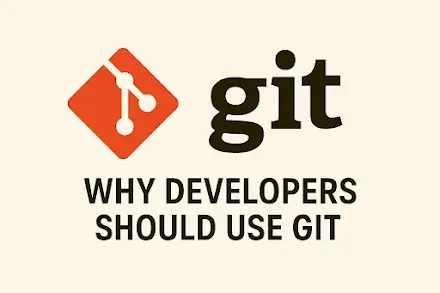What is Git and Why is it Important for Developers?
Tools that help manage code efficiently are essential in today's fast-paced software development world. One of the most vital tools in a developer's toolkit is Git. But what exactly is Git, and why has it become a must-know technology for developers across the globe? This blog post dives deep into Git, its core functions, and the reasons why every developer should learn to use it.
 |
| Go |
What is Git?
Git is a distributed version control system (VCS) created by Linus Torvalds in 2005, the same individual who developed the Linux kernel. It was built to handle everything from small to huge projects quickly and efficiently.
At its core, Git helps developers:
- Track changes made to the source code.
- Collaborate with other developers.
- Manage multiple versions of a project.
- Revert to the previous code if needed.
Unlike older version control systems like CVS or Subversion, Git is distributed. This means every developer has a full copy of the repository, including its complete history. This design makes Git faster, more secure, and more resilient than centralized systems.
How Does Git Work?
To understand why Git is so important, it helps to know how it works. Git operates through a series of commands that developers use to track, manage, and update code.
1. Repository (Repo)
A repository is the heart of a Git project. It contains all the project files and the complete history of changes.
Local Repository – The version stored on your own computer.
Remote Repository – A version hosted on platforms like GitHub, GitLab, or Bitbucket, enabling collaboration.
2. Commit
A commit is like taking a snapshot of your files at a certain point in time. Each commit includes a message that describes what changes were made.
3. Branch
Branches allow developers to work on new features or bug fixes without affecting the main codebase. Once a feature is complete, it can be merged into the main branch.
4. Merge
Merging integrates changes from different branches. It's how development work comes together.
Why is Git Important for Developers?
Now that you understand what Git is and how it works, let's dive into why it's considered indispensable in software development.
1. Efficient Collaboration
Git allows multiple developers to work on the same project simultaneously. Using branches, each developer can work independently without overwriting each other's work. When ready, their changes can be merged, making Git ideal for team collaboration.
2. History and Version Control
Every time a change is committed, Git saves that version. This creates a complete history of the project. If something breaks or a bug is introduced, developers can easily revert to a previous version, saving time and effort.
3. Open Source and Free
Git is free and open-source, which means any developer or organization can use it without licensing fees. Its open nature also means it's constantly being improved by the community.
4. Widely Adopted
Git is the industry standard. Platforms like GitHub, GitLab, and Bitbucket are built on Git. Most modern development tools and IDEs have built-in Git support. Knowing Git is a must-have skill in the tech industry.
5. Supports Agile and DevOps
Agile development and DevOps practices rely heavily on Git. Features like Continuous Integration/Continuous Deployment (CI/CD) require strong version control to automate testing and deployment. Git's branching and merging capabilities make it a perfect fit.
Real-World Example: Using Git in a Project
Imagine a team of five developers building a web application. Each developer is responsible for different components: frontend, backend, database, API, and testing.
- Each developer creates their own branch from the main codebase.
- They work on their tasks independently, committing changes regularly.
- Once features are ready, they push their changes to a remote repository like GitHub.
- The team reviews each other's work through pull requests.
- After approval, changes are merged into the main branch.
Throughout the process, Git provides a complete trail of who did what, when, and why. It also prevents code conflicts and facilitates smooth collaboration.
Common Git Commands Every Developer Should Know
To get started with Git, here are some basic commands:
git init – Initialize a new Git repository.
git clone – Create a local copy of a remote repository.
git add – Stage changes for commit.
git commit -m "message" – Commit changes with a message.
git status – View current changes and staging status.
git push – Upload commits to a remote repository.
git pull – Fetch and merge updates from a remote repository.
git branch – List, create, or delete branches.
git merge – Merge changes from one branch into another.
Learning these commands is the first step towards becoming a Git pro.
The Role of Git in Career Growth
Understanding Git can significantly boost your career as a developer. Employers look for developers who are familiar with Git, as it ensures seamless team integration. It also shows that you can handle collaborative projects and maintain clean, version-controlled code.
For freelance developers, Git is a powerful way to manage multiple client projects. For students and learners, using Git builds good coding habits and showcases projects on platforms like GitHub — a great portfolio booster.
Final Thoughts
Git is more than just a tool — it's a vital part of modern software development. From solo developers to large enterprise teams, Git helps manage code efficiently, collaborate seamlessly, and maintain high-quality software. If you're serious about becoming a professional developer, learning Git is not optional; it's essential.
Whether you're working on a passion project or contributing to a billion-dollar product, Git is the backbone that keeps your code organized, safe, and ready to grow.




